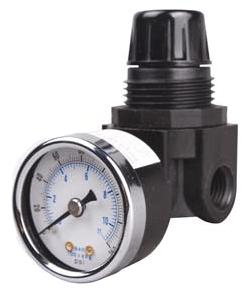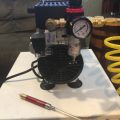Why does my air compressor have two air gauges? There are two as each of the two gauges provide important functions for the air compressor owner. Explaining the two gauges is easier if we have a brief review of how the compressor works.
When the air in the tank lowers due to use of compressed air, one of the gauges, the tank air gauge, will display that dropping pressure. In other words, the one gauge is the Tank Air Gauge, displaying the level or PSI of air in the tank.

When the compressor tank pressure drops to the point where the pressure switch trips to allow power to flow to the motor, the compressor starts. Air pressure starts building the in the tank again, and that rising pressure is displayed on the tank air gauge.
Cut out pressure is important
Periodically monitoring the rising tank pressure by watching the tank gauge from time to time is important. The pressure in the tank, and the PSI displayed on the tank gauge should stop at the same pressure level and gauge reading every time. That’s the compressor cut out pressure setting. Let’s agree, for sake of example, that the cut out pressure setting of a particular compressor is 150 PSI.
If the tank pressure gauge displays a pressure setting that is below that 150 PSI by a reasonable margin, say 5 PSI, and the compressor stops running, that will indicate that the compressor has a problem.
Perhaps it is the pressure switch that is malfunctioning. The pressure switch is supposed to trip on at the low pressure cut in, and cut off the compressor motor at the high pressure cut out, if it’s working properly. That means, when the compressor stops the tank pressure reading should be 150 PSI. If it’s not within that by 5 PSI (to allow for gauge variances) then the compressor will need servicing.
By the same token, if the tank pressure drops below the normal cut in pressure of that compressor, that, too, can indicate an issue with the pressure switch or some other problem with the compressor.
What if the tank gauge reading is too high?
If the tank pressure gauge starts displaying a PSI or pressure reading that is higher than the normal cut out pressure setting, by 5 PSI or more, that, too, indicates a problem with the pressure switch. If that happens, tank pressure may rise higher and higher, until the pressure relief valve (PRV) cracks open and vents over-pressure before it can create a very dangerous situation.
If that happens, get the problem fixed fast as that compressor has a critical problem that could be come very hazardous if the PRV should not provide the backup pressure relief it is supposed to for any reason.
Get the pressure switch fixed!
And that’s why the tank gauge is important.
Pressure gauge 2 – the regulator gauge
The other pressure gauge on the typical compressor will be either threaded into or connected to the compressor regulator.

This second air gauge purpose is to display for the compressor operator the pressure setting of the downstream air. In other words, this gauge shows the operator the pressure of the air that will flow from the compressor through the air line to the air tool.
The maximum air pressure this gauge will display will be the same as the highest pressure level displayed on the tank gauge. The regulator, and by connection to it the regulator gauge, cannot show a pressure that’s higher than the tank pressure. The displayed pressure cannot be “dialed up” past the pressure level available in the tank. The purpose of the regulator is to REDUCE the downstream air pressure below the maximum pressure of the tank. This will help ensure a steady flow of air at the same pressure to the air tool.
When air is used the regulator gauge display can drop quickly if the air tool is using a lot of air. If the air tool is a one-shot device like a nailer, the regulator gauge will display a momentary drop in the pressure setting as air is drawn through the regulator to trigger the nailer, and then the regulator gauge will (or should) display the set pressure again.
If the air tool being used is a high demand, continuous running tool like a sander, as air is consumed the air available to the tool from the tank will drop, and the regulator gauge will display that drop when the tank pressure falls below the regulator setting and if the air being consumed is higher than that which the compressor can build back up.
Monitoring the regulator gauge as an variety of air tools are being used can help inform the operator if there is a problem with air supply to the tool, and, if the regulator gauge does not react to the varying pressures in the system properly either indicate an issue with the air supply or with the regulator itself.
Why does my air compressor have two air gauges? Both are necessary for the safe, effective use of the compressor, and the monitoring of that compressors function. Use the gauges to ensure your compressor works at its optimum. For comments or questions about this page, please use the comment section below.





![Using an Air Compressor to Clean Your Computer [GUIDE]](https://fix-my-compressor.com/wp-content/uploads/2022/12/cleaning-a-pc-with-an-air-compressor-120x120.jpg)
